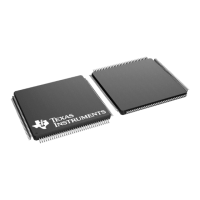Usage Notes and Known Design Exceptions to Functional Specifications
www.ti.com
4
SPRZ412K–December 2013–Revised February 2020
Submit Documentation Feedback
Copyright © 2013–2020, Texas Instruments Incorporated
TMS320F2837xD Dual-Core MCUs Silicon Revisions C, B, A, 0
4.1.3 SYS/BIOS: Version Implemented in Device ROM is not Maintained
Revision(s) Affected: 0, A, B, C
The SYS/BIOS version 6.37 in ROM cannot be updated to address bug fixes or enhancements. For
applications using this ROM version of SYS/BIOS, the user should review the release notes on the
SYS/BIOS Product Releases page to assess any application impact to known bugs.
To use the latest maintained SYS/BIOS version, download the SYS/BIOS library and include in the
application flash image instead of using the ROM version.
4.1.4 SDFM: Use Caution While Using SDFM Under Noisy Conditions
Revision(s) Affected: 0, A, B, C
The SDFM clock input (SDx_Cy) directly clocks the SDFM module when there is no GPIO input
synchronization. Any glitches or ringing noise on the SDx_Cy input beyond V
IH
or V
IL
can corrupt the
SDFM module, leading to unpredictable results.
Workaround(s):
SDFM GPIO Asynchronous Mode:
Special attention should be taken during board design to ensure a clean and noise-free signal that meets
the SDFM timing requirements. Precautions such as series termination for ringing due to any impedance
mismatch of the clock driver, and spacing of traces from other high-frequency signals are recommended.
SDFM GPIO Qualification (3-sample) Mode:
It is highly recommended that the SDFM GPIO qualification mode be used in noisy conditions. This mode
provides additional protection by filtering both SDx_Cy and SDx_Dy inputs from system noise. Refer to the
"SDFM Timing Requirements When Using GPIO Input Qualification (3-Sample Window)" table in the
TMS320F2837xD Dual-Core Microcontrollers Data Manual when using this option.
When a noise event occurs while using the GPIO Qualification mode, there may still be data disturbance,
but it will be proportional to the duration of the noise event and typically filtered by the oversampling of the
SDFM module. Below is a relative listing of each SDFM mode's sensitivity to data variation in the
presence of severe system noise.
• Mode 0: This mode is the best performing mode. It is the recommended mode under noisy conditions.
• Mode 1 and Mode 3: The error in these modes can be twice as large as the error in Mode 0 since each
noise glitch can introduce error for multiple data bits.
• Mode 2: This option is unavailable when using GPIO qualification. This mode is not recommended for
either GPIO ASYNC or GPIO qualification.

